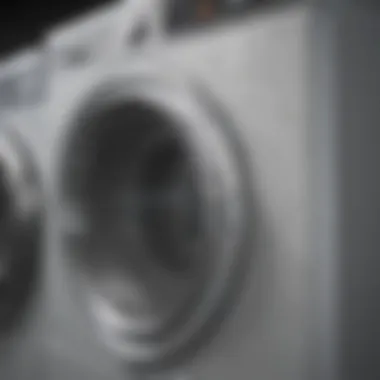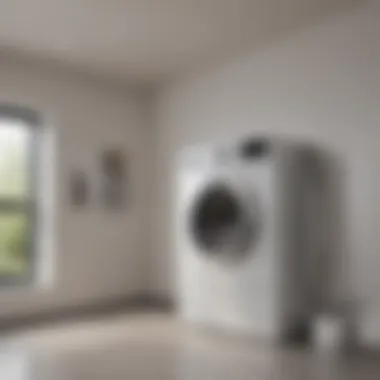Understanding Dryer Exterior Heat: Causes and Solutions


Intro
Elevated temperatures on dryer exteriors can lead to serious concerns for homeowners. While some warmth is expected, an excessively hot surface could signal underlying issues that require immediate attention. Understanding what constitutes normal heat levels is essential for ensuring safe appliance operation.
This article explores various causes of abnormal heat, safety implications, and practical solutions. An informed assessment of your dryer’s condition contributes to its longevity and efficiency.
Throughout the following sections, we will address key points, examining components that can cause increased exterior temperatures while providing actionable insights into maintaining a well-functioning appliance.
Ultimately, this investigation serves to enhance both the safety and effectiveness of your dryer, promoting a secure home environment.
Causes of Elevated Temperatures
Several factors can contribute to an abnormal heat on the exterior of a dryer. It's essential to understand these causes for effective assessment and maintenance.
- Lint Build-Up: Over time, lint can accumulate in the venting system. This buildup restricts airflow and may result in excess heat on the dryer surface.
- Faulty Thermostat: A malfunctioning thermostat can disrupt normal heating cycles, causing the dryer to overheat.
- Improper Installation: If the dryer is not installed correctly, issues such as blocked vents can arise. This error can encourage heating problems.
Understanding the potential issues faced by your dryer is critical. Regular maintenance and inspections will help prevent advanced problems.
Safety Concerns
High exterior temperatures pose risks. Primarily, extreme heat can lead to fire hazards. Additionally, it can incapacitate the dryer’s efficiency, potentially causing higher energy bills.
Homeowners should also consider the risk of burns if they accidentally touch a hot exterior. Keeping surfaces cool is not merely about comfort; it's a matter of safety.
- Check for steam or heat emanating from the dryer door while in operation.
- Observe the dryer’s environment; it should not be too crowded.
- Ensure no flammable items are stored nearby.
Operational Efficiency
A dryer’s efficiency can be compromised by heat-related issues. Excessive exterior temperatures can indicate that the appliance is working harder than necessary, leading to potential damage.
Factors that affect efficiency include:
- Regular lint cleaning to promote optimal airflow.
- Utilizing the right drying cycles for different materials.
- Ensuring that vents are suited for the space and not overly long.
Improving these aspects can enhance the overall operational efficacy of the dryer.
Preventive Measures
Implementing preventive measures can greatly affect the performance and safety of your dryer. Here are practical steps to consider:
- Routine Maintenance: Clean lint filters after every use. Schedule professional cleanings for the vent system.
- Temperature Checks: Use an infrared thermometer to monitor external heat. This tool can provide clear readings on surface temperatures.
- User Manual Review: Always refer to the manufacturer’s guidelines. This practice ensures that you follow the recommendations tailored for your specific model.
By adopting these proactive measures, you can significantly mitigate the risks associated with excessive heat on the exterior of your dryer.
When to Seek Professional Assistance
Recognizing when expert help is needed is key for ensuring dryer safety and performance. Seek professional assistance in the following scenarios:
- Consistent overheating despite proper maintenance efforts.
- Any signs of electrical issues or unusual noises during operation.
- Persistent problems with drying efficiency, even after adjusting settings.
Understanding the limits of your ability to troubleshoot will help maintain the functionality of your appliance.
Closure


Assessing and managing heat levels on dryer exteriors is crucial for maintaining safety and efficiency. Identifying root causes, implementing preventive measures, and knowing when to consult professionals can significantly improve the appliance's longevity.
By investing time in understanding these essentials, homeowners can foster a safer home environment while ensuring their dryers function optimally.
Understanding Dryer Temperature Dynamics
Understanding the temperature dynamics within your dryer is critical for safe and efficient operation. The way a dryer heats up and maintains its temperature can significantly affect both its performance and longevity. Knowing what constitutes a normal temperature range ensures that users can identify abnormal conditions that may lead to more serious issues. Here are the elements that make this understanding essential:
- Safety: High exterior temperatures may indicate underlying problems, such as inadequate airflow or malfunctioning components. By understanding the normal temperature range, one can discern when to take action.
- Efficiency: Operating your dryer at optimal temperatures improves drying performance. When a dryer does not reach or maintain sufficient heat, drying cycles can extend, leading to prolonged energy consumption and higher utility bills.
- Longevity: Awareness of temperature dynamics can prolong the lifespan of the appliance. Overheating may lead to wear and tear on components, whereas maintaining optimal conditions can keep the dryer in top shape for years.
Users must consider these aspects to make informed decisions about their dryers. Regular monitoring and evaluation can manifest improved safety and efficiency.
Normal Operating Temperatures
The normal operating temperature for most household dryers typically ranges between 125°F to 135°F (about 51°C to 57°C). This range allows the dryer to effectively evaporate moisture from clothes without causing damage to the fabric or the appliance itself. It is important to note, however, that different dryers may have slightly different specifications.
To assess whether the exterior heat is within an acceptable range, users can perform the following checks:
- Touch Test: A dryer that feels very hot to the touch could indicate a problem. However, a warm surface surface may be expected.
- Thermometer Check: Using an infrared thermometer can provide precise temperature readings, enabling users to know exactly how hot their dryer is running.
- Manufacturer Specifications: Referring to the dryer’s user manual or manufacturer guidelines can reveal specific temperature settings that should be monitored.
Factors Affecting Drying Efficiency
Drying efficiency can be influenced by multiple factors that affect how effectively heat transfers and moisture is expelled. Here are some key contributors:
- Load Size: Overloading the dryer can restrict airflow and hinder heat circulation. This ultimately leads to increased drying time and extra energy consumption.
- Lint Buildup: Accumulated lint can block vents and ducts, significantly obstructing airflow. Regular cleaning is necessary to maintain optimal performance.
- Ventilation System: Proper installation and maintenance of the venting system ensure that moist air is effectively expelled. Poor ventilation limits the dryer’s efficiency.
- Moisture Sensor: Many modern dryers come equipped with moisture sensors that gauge the dampness of clothes. If these sensors malfunction, they may not release adequate heat or time the drying cycle appropriately, affecting overall performance.
These factors play a crucial role in determining the efficiency of drying cycles. Addressing them can maximize dryer performance and safeguard against excessive heat on the exterior.
Assessing Heat Levels on Your Dryer
Assessing heat levels on your dryer is crucial for ensuring its safe and efficient operation. Homeowners often overlook this aspect, yet understanding what constitutes acceptable temperatures can significantly impact appliance longevity and safety. This section explores how to recognize excessive heat, which not only indicates appliance issues but can also lead to potential hazards, including fire risks.
The advantages of regularly monitoring the exterior heat of your dryer cannot be overstated. It allows you to identify problems before they escalate. Moreover, a well-functioning dryer enhances energy efficiency, ultimately saving money on utility bills. Keeping a close eye on dryer heat levels ensures that your appliance operates within its designed specifications. Learning to assess this heat correctly equips you with the knowledge necessary to maintain the efficiency and safety of your laundry equipment.
Recognizing What is Considered Hot
In terms of dryer exteriors, what feels hot may not always mean there is a malfunction. Generally, warm surfaces during operation can be expected due to the heat generated during the drying process. However, two factors are important in this context: the temperature of the surfaces you can touch and its impact on performance.
- Normal Temperature Range: A well-functioning dryer usually has an exterior temperature between 90°F and 120°F during operation. While this range may vary somewhat, any temperature rising above this threshold may warrant further investigation.
- Unusual Heat Signals: If you observe that your dryer is excessively hot, or the housing feels painful to touch, this could indicate an underlying problem, such as heating element malfunctions or airflow restrictions.
- Touch Test: A practical method to gauge excess heat is to perform a touch test. Lightly place your hand on the dryer's exterior. If it is too uncomfortable to hold for more than a few seconds, your dryer may be experiencing issues.
Comparative Analysis: Feeling Your Dryer vs. Its Efficiency
It is vital to differentiate between your dryer merely feeling hot and being inefficient. These factors often coexist but do not necessarily indicate the same underlying problems. Understanding their differences can prevent misinterpretation of symptoms, leading to more informed corrective measures.
- Feel of Heat vs. Actual Performance: You may notice a warm exterior, but this does not always correlate with the efficiency of drying cycles. Instead, assess whether your dryer is doing its job. Is it taking longer than usual? Are clothes coming out damp? These signs can indicate performance issues despite what the exterior heat suggests.
- Energy Consumption: A dryer that feels excessively hot may consume more energy but fail to produce dry clothes effectively. Pay attention to your utility bills as a warning signal for inefficiency. A spike in energy use often indicates operational problems.
- Systematic Evaluation: It’s recommended to keep a check on cycle times and monitor the performance consistently. This goes hand in hand with understanding the degree of heat during operation.
"Regular monitoring ensures your appliance remains efficient and safe, potentially saving you from costly repairs and hazards."
This comparative perspective emphasizes the need for a critical approach when evaluating your dryer’s functionality. Always weigh the sensations of heat against actual performance indicators to make informed decisions. By doing so, you maintain a safe and efficient laundry environment.
Common Causes of Increased Exterior Heat
Understanding the common causes of increased exterior heat on dryers is vital for homeowners. Excessive heat can indicate operational issues which may lead to safety hazards or deteriorating appliance performance. By being aware of these causes, users can take precautionary measures to safeguard their homes and ensure dryer efficiency.


Poor Ventilation and Airflow Issues
Poor ventilation is one of the persistent culprits behind overheating. When your dryer lacks sufficient airflow, humidity cannot escape effectively from the drying process. This accumulated moisture leads to increased temperatures on the exterior.
- Impact of Poor Airflow: When airflow is blocked, the dryer works harder to dry clothes. This excessive strain can lead to overheating.
- Indicators of Ventilation Problems: Hot odors, longer drying times, and very hot surfaces are crucial signs.
To improve ventilation, ensure that the dryer’s vent is not obstructed. Cleaning the lint trap before every load can help maintain airflow. If possible, leave space around the dryer for air circulation.
Blocked Vent Ducts and Lint Buildup
Blocked vent ducts are a common issue that cannot be overlooked. Lint can accumulate in ducts, limiting airflow and increasing heat levels significantly. This buildup not only raises temperature but also creates a fire hazard.
- Warning Signs of Blocked Ducts: Look out for unusual noises, increased drying times, and dryer that feels unusually hot.
- Cleaning Ducts: Regular cleaning of ducts is recommended. Use a vacuum or professional services that specifically clean dryer vents to mitigate risk.
Malfunctioning Thermostat and Temperature Sensors
A malfunctioning thermostat or temperature sensor can lead to improper heat regulation. If these components fail, the dryer may operate beyond safe heat levels.
- Risks: Overheating from faulty sensors can cause the dryer to enter unsafe temperature ranges, damaging both the appliance and your clothing.
- Diagnosing the Problem: If your dryer continues to heat excessively, it may be time to check these components. Testing the thermostat with a multimeter can indicate if it’s functioning properly.
Electrical Problems and Overheating Components
Electrical issues can also cause excessive heat in dryers. Problems such as short circuits, faulty wiring, or overheating components create a high-risk environment. Unstable electrical connections can lead to power surges, putting additional strain on the dryer’s interior parts.
- Identifying Electrical Issues: Flickering lights or tripped circuit breakers may signal that your dryer is drawing too much power.
- Immediate Action Required: If you suspect electrical problems, it’s advisable to disconnect the dryer immediately and consult a professional technician. Addressing electrical issues promptly can avoid dangerous scenarios.
Regular examination of your dryer's components can not only enhance performance but also extend its lifespan.
Safety Concerns Related to Excessive Heat
Understanding the safety concerns related to excessive heat on dryer exteriors is crucial not only for appliance longevity but also for the safety of your home. Elevated temperatures can indicate underlying problems which, if left unattended, may lead to serious risks, including fire hazards and damage to clothing. Thus, it is important for homeowners and appliance users to recognize these risks, assess their dryers regularly, and take appropriate preventive measures.
Risk of Fire Hazards
One of the most alarming risks associated with high exterior heat on dryers is the potential for fire. Clothes dryers can produce significant heat during operation, but when that heat becomes too excessive, it can ignite lint or other flammable materials trapped within components of the dryer. According to the U.S. Fire Administration, lint buildup is a leading cause of dryer fires. This ignites a serious concern for those who operate dryers regularly.
Avoiding this risk entails understanding the signs of overheating. If the exterior of your dryer feels excessively hot to the touch, it may be an indication of overheating issues or blockage in the venting system. Factors such as poor ventilation, clogged vents, or malfunctioning components can contribute to higher temperatures on the dryer surface. Regular maintenance—including cleaning lint filters and ensuring vent ducts are clear—is vital in minimizing these risks and preventing hazardous situations.
Damage to Clothing and Fabrics
In addition to fire hazards, excessive heat on dryer exteriors can lead to damage not only to the dryer itself but also to the items being dried. High temperatures may cause fabrics to degrade, leading to shrinkage, fading, or even melting of synthetic materials. This can compromise the quality and usability of your clothes, which is particularly disconcerting for those who invest in high-quality or delicate fabrics.
When assessing heat levels, regular observation can be beneficial. If you notice that your garments are appearing worn out or damaged after drying, it may relate to the heat levels generated during cycles. Investing in proper dryer sheets, ensuring correct drying settings, and adjusting load sizes can help mitigate the risk of fabric damage caused by high temperatures.
Ultimately, addressing safety concerns related to excessive heat in dryers is essential. By understanding the risks of fire hazards and potential damage to clothing, users can take proactive steps to ensure a safe and efficient drying experience.
Evaluating Dryer Efficiency
Evaluating the efficiency of your dryer is essential to ensure not only effective performance but also safety in your home. Modern dryers are designed to operate optimally within a specific range of temperatures and energy usage. When these standards are not met, it can lead to various problems, such as increased heating, longer drying times, and elevated energy bills. Understanding the indicators of efficiency allows homeowners to troubleshoot issues proactively and implement solutions that can extend the lifespan of their appliance while maintaining safety standards in their home.
Signs of Inefficiency in Drying Cycles
Identifying signs of inefficiency in your dryer’s drying cycles can prevent minor issues from escalating. Here are several notable indicators you should watch for:


- Extended Drying Times: If clothing takes significantly longer to dry than usual, it may signal inadequate heat or airflow issues.
- Uneven Drying: Clothes may come out both damp and dry, indicating that the dryer is not distributing heat properly. This could also suggest airflow problems.
- Recurrent Overheating: A dryer that frequently feels excessively hot on the outside or triggers thermal overload protection may have poorly functioning components.
- Increased Energy Usage: Noticing a spike in energy consumption on your bill can indicate inefficiency, possibly linked to heat retention problems or an obstructed vent.
"Regularly monitoring your dryer’s performance is key to maintaining its efficiency and safety."
Comparing Energy Consumption Rates
Energy consumption rates are a crucial aspect to analyze when assessing dryer efficiency. Understanding how much energy your dryer uses can provide valuable insights into its operational effectiveness and its impact on utility costs.
Factors to consider include:
- Energy Star Ratings: Compare models based on their efficiency ratings. Energy Star-certified dryers typically consume less energy than non-certified ones and offer better performance.
- Usage Patterns: Evaluating your own usage pattern can help you identify whether your dryer operates efficiently, especially during peak standing energy hours, which may skew costs.
- Cost per Cycle: Calculate the cost of operating your dryer on a per-cycle basis. This can help you understand which loads utilize the most energy and enable future savings through better load management.
- Venting Efficiency: Ensure that venting is correctly installed and unobstructed, as this can significantly influence energy consumption.
By comparing energy consumption rates, you ensure that you select appliances that perform well without excessive cost, reflecting a truly efficient dryer.
Preventive Measures for Optimal Dryer Performance
Ensuring optimal dryer performance goes beyond merely observing heat levels on the exterior. Regular preventive measures can significantly enhance the functionality and lifespan of the appliance. An effective approach reduces the risk of overheating and improves energy efficiency. It is essential for homeowners to take proactive steps in maintaining their dryers to prevent potential problems that may arise from neglect.
Regular Maintenance and Cleaning
Routine upkeep of your dryer is vital. The accumulation of lint, dust, and debris can compromise ventilation, leading to excessive heat on the exterior. Cleaning the lint trap before every cycle should be a standard practice. Additionally, you should schedule thorough vent cleaning at least once a year. This involves removing lint buildup from the vent ducts and ensuring unobstructed airflow.
Regular maintenance not only protects against overheating but also enhances drying efficiency. When airflow is adequate, the dryer operates at optimal levels, reducing energy consumption and ensuring clothes dry as intended.
Regular cleaning can extend the appliance life and prevent costly repairs.
Proper Dryer Vent Installation
It is crucial to install the dryer vent correctly. A poorly installed vent can trap heat and moisture, causing the exterior to feel excessively warm. Ensure that vents are short, straight, and clear of bends where lint can accumulate. Using metal ducts instead of plastic ones can also make a significant difference in eliminating fire hazards associated with overheating.
Coordination with a professional during installation may prevent complications later. It is advisable to check venting systems periodically to confirm they remain functional and free from obstructions.
Utilizing Quality Dryer Sheets and Products
The choice of dryer sheets and fabric softeners can influence dryer performance as well. Opting for high-quality products prevents residue buildup within the appliance. Some inferior products contain chemicals that can adversely affect internal components, deteriorating efficiency over time.
By using recommended products, the dryer operates more smoothly, which in return, minimizes friction and heat generation. Ensure to research and select well-reviewed options to maximize benefit and maintain your dryer’s functionality.
Overall, addressing preventive measures such as regular maintenance, proper installation, and product quality cultivates an efficient drying process and preserves the appliance’s condition.
When to Seek Professional Help
When it comes to assessing heat levels on dryer exteriors, knowing when to call a professional is crucial for maintaining both safety and operational efficiency. Not all heat is a cause for alarm, but certain symptoms can indicate serious problems that need expert attention. Ignoring these signs might lead to further damage and potential hazards. It is important to recognize when the situation surpasses basic troubleshooting and requires specialized knowledge or tools.
Identifying Signs of Malfunction
There are several indicators that may suggest your dryer is not functioning properly. One primary sign is excessive heat on the exterior casing. If the surface of the dryer feels uncomfortably hot to the touch, this could be a signal that an internal issue is causing unnecessary heat accumulation. Additionally, you may observe that the dryer takes longer than usual to dry clothes effectively, a condition that can stem from airflow blockages or malfunctioning sensors.
Other signs include unusual noises such as grinding or squeaking, which often indicate mechanical problems. A burning smell is another serious warning signal that should never be overlooked. Should you encounter any of these symptoms, it is vital to take immediate action. Documenting the observed signs can help a technician diagnose the issue more efficiently.
Understanding Warranties and Repair Options
Before seeking professional help, it is wise to review your appliance’s warranty. Many dryers come with a manufacturer’s warranty that covers specific types of mechanical failures and repairs. Understanding the terms of this warranty can save you considerable expenses if your dryer is still covered. Check for defects and limitations in warranty coverage, as some damages may not be included.
In addition to warranties, there are various repair options available. You have the choice between authorized service centers, independent technicians, or handyman services. Weighing the benefits and drawbacks of each option is crucial. Authorized technicians may offer more reliable service but can be pricier. Independent technicians can be more affordable but may not guarantee parts and labor in the same way. Make sure to consider both cost and quality of service when selecting a repair option.
It is crucial to act promptly when viewing signs of malfunction. Proactive measures may prevent larger, costly repairs down the line.
In summary, knowing when to seek professional help can aid in preventing further complications and ensuring the safety and longevity of your dryer. Always stay vigilant for warning signs and understand your warranty and repair options to make informed decisions.



